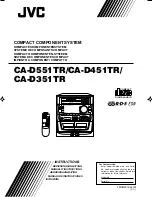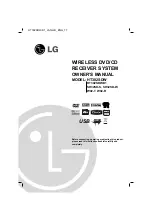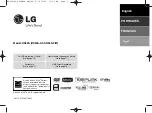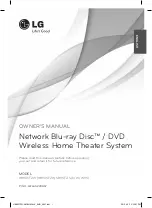
SD-AS10
8 – 2
IC101 VHiCS493264-1: DSP (CS493264) (2/2)
Pin No.
Terminal Name
Input/Output
Function
25
SCLKN1, STCCLK2
Input
Bidirectional digital-audio bit clock that is an output in master mode and an input in slave
mode. In slave mode, SCLKN1 operates asynchronously from all other CS493XX clocks.
In master mode, SCLKN1 is derived from the CS493XX internal clock generator. In either
master or slave mode, the active edge of SCLKN1 can be programmed by the DSP.
For applications supporting PES layer synchronization this pin can be used as STCCLK2,
which provides a path to the internal STC 33 bit counter.
26
LRCLKN1
Input
Bidirectional digital-audio frame clock that is an output in master mode and an input in slave
mode. LRCLKN1 typically is run at the sampling frequency.
In slave mode, LRCLKN1 operates asynchronously from all other CS493XX clocks. In mas-
ter mode, LRCLKN1 is derived from the CS493XX internal clock generator. In either master
or slave mode, the polarity of LRCLKN1 for a particular subframe can be programmed by the
DSP.
27
CMPDAT, SDATAN2
Input
Digital-audio data input that can accept from one to six channels of compressed or PCM
data. SDATAN2 can be sampled with either edge of SCLKN2, depending on how SCLKN2
has been configured. Similarly CMPDAT is the compressed data input pin when the CDI is
configured for bursty delivery. When in this mode, the CS493XX internal PLL is driven by the
clock recovered from the incoming data stream.
28
CMPCLK, SCLKN2
Input
Bidirectional digital-audio bit clock that is an output in master mode and an input in slave
mode. In slave mode, SCLKN2 operates asynchronously from all other CS493XX clocks.
In master mode, SCLKN2 is derived from the CS493XX internal clock generator.
In either master or slave mode, the active edge of SCLKN2 can be programmed by the DSP.
If the CDI is configured for bursty delivery, CMPCLK is an input used to sample CMPDAT.
29
CMPREQ, LRCLKN2
Input
When the CDI is configured as a digital audio input, this pin serves as a bidirectional digital-
audio frame clock that is an output in master mode and an input in slave mode.
LRCLKN2 typically is run at the sampling frequency.
In slave mode, LRCLKN2 operates asynchronously from all other CS493XX clocks.
In master mode, LRCLKN2 is derived from the CS493XX internal clock generator.
In either master or slave mode, the polarity of LRCLKN2 for a particular subframe can be
programmed by the DSP.
When the CDI is configured for bursty delivery, or parallel audio data delivery is being used,
CMPREQ is an output which serves as an internal FIFO monitor. CMPREQ is an active low
signal that indicates when another block of data can be accepted.
30
CLKIN
Input
CS493XX clock input. When in internal clock mode (CLKSEL == DGND), this input is con-
nected to the internal PLL from which all internal clocks are derived.
When in external clock mode (CLKSEL == VD), this input is connected to the DSP clock.
31
CLKSEL
Input
This pin selects the clock mode of the CS493XX.
When CLKSEL is low, CLKIN is connected to the internal PLL from which all internal clocks
are derived. When CLKSEL is high CLKIN is connected to DSP clock.
32, 33
FILT2, FILT1
—
Connects to an external filter for the on-chip phase-locked loop.
34
VA
Input
Analog positive supply for clock generator. Nom2.5 V.
35
AGND
—
Analog ground for clock generator PLL.
36
RESET
Input
Asynchronous active-low master reset input. Reset should be low at power-up to initialize
the CS493XX and to guarantee that the device is not active during initial power-on stabiliza-
tion periods. As the rising edge of reset the host interface mode is selected contingent on the
state of the RD, WR and PSEL pins. Additionally, an autoboot sequence can be initiated if a
serial control mode is selected and ABOOT is held low.
If reset is low all bidirectional pins are high impedance inputs.
37, 38
DD, DC
—
This pin is reserved and should be pulled up with an external 4.7 k resistor.
39, 40
AUDATA2, AUDATA1
Output
PCM multi-format digital-audio data output, capable of two-channel 20-bit output.
This PCM output defaults to DGND as output until enabled by the DSP software.
41
AUDATA0
Output
PCM multi-format digital-audio data output, capable of two-, four-, or six-channel 20-bit out-
put. This PCM output defaults to DGND as output until enabled by the DSP software.
42
LRCLK
Input
Bidirectional digital-audio output-sample-rate clock. LRCLK can be an output that is divided
from MCLK to provide the output sample rate depending on the output configuration.
LRCK can also be an input. As an input LRCLK is independent of MCLK.
43
SCLK
Input
Bidirectional digital-audio output bit clock. SCLK can be an output that is derived from MCLK
to provide 32 Fs, 64 Fs, 128 Fs, 256 Fs, or 512 Fs, depending on the MCLK rate and the dig-
ital-output configuration. SCLK can also be an input and must be at least 48 Fs or greater.
As an input, SCLK is independent of MCLK.
44
MCLK
Input
Bidirectional master audio clock. MCLK can be an output from the CS493XX that provides
an oversampled audio-output clock at either 128 Fs, 256 Fs, or 512 Fs.
MCLK can be an input at 128 Fs, 256 Fs, 384 Fs, or 512 Fs. MCLK is used to derive SCLK
and LRCLK when SCLK and LRCLK are driven by the CS493XX.
Summary of Contents for SD-AS10
Page 24: ...SD AS10 3 9 ASSEMBLY SEQUENCE 1 FIX ITEM 148 157 TO ITEM 115 148 157 115 5 ...
Page 50: ...SD AS10 3 35 178 ASSEMBLY SEQUENCE 1 FIX ITEM 178 TO MAIN CHASSIS ASSY 31 ...
Page 53: ...SD AS10 3 38 M E M O ...
Page 75: ...SD AS10 5 4 6 6 ...
Page 186: ... M E M O SD AS10 ...
Page 187: ... M E M O SD AS10 ...
















































